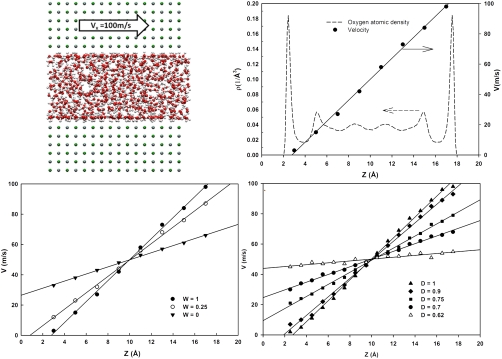Fig. 2.
(Upper) Simulation snapshot illustrating the protocol implemented to study the transport properties for confined water in a Couette flow (Left). The bottom surface is maintained in its fixed position, whereas the top one is moved with constant velocity of 100 m/s (0.001 A/fs) along the X direction. When the Couette flow is fully established we can study the density profile of the oxygen atoms of the confined water, as well as the velocity of the confined water molecules along the X direction as a function of their position within the narrow slit-shaped channel (Right; example for MgO substrate). When the velocity of the water molecules in contact with the solid substrates equals that of the solid (as in the case of MgO) the simulations suggest no slip. On the contrary, when the water velocity in contact with the solid surface differs from that of the solid, hydrodynamic liquid slip is observed. (Lower) Velocity profiles for confined water molecules as a function of the position within the narrow slit-shaped channel when reducing W from 1 to 0 (Left) or D from 1 to 0.62 (Right). In all cases T = 300 K. The results show that when W = 0.25 slip begins to be observed (it becomes very evident at W = 0). More interestingly, slip is also detected for hydrophilic surfaces, when D is 0.75 or less. Lines are guides to the eye. Estimations for slip lengths, useful for hydrodynamic calculations, can be attained by extrapolating the velocity profiles shown above to the distance at which the fluid velocity equals the surface velocity (34). For example, when D = 0.62 the slip length is approximately 6.7 nm.

